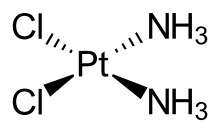Radiosensitizer
A radiosensitizer is an agent that makes tumor cells more sensitive to radiation therapy. It is sometimes also known as a radiation sensitizer or radio-enhancer.

Mechanism of action
Conventional chemotherapeutics are currently being used in conjunction with radiation therapy to increase its effectiveness. Examples include the fluoropyrimidines, gemcitabine and platinum analogs; fluoropyrimidines increase sensitivity by dysregulating S-phase cell cycle checkpoints in tumor cells. Gemcitabine progresses through a similar mechanism, causing cells in the S-phase to disrepair DNA damage caused by the radiation. Platinum analogs such as cisplatin inhibit DNA repair by cross linking strands, and so aggravate the effects of DNA damage induced by radiation.[1]
Limitations
One of the major limitations of radiotherapy is that the cells of solid tumors become deficient in oxygen. Solid tumors can outgrow their blood supply, causing a low-oxygen state known as hypoxia. Oxygen is a potent radiosensitizer, increasing the effectiveness of a given dose of radiation by forming DNA-damaging free radicals. Tumor cells in a hypoxic environment may be as much as 2 to 3 times more resistant to radiation damage than those in a normal oxygen environment.[2] Much research has been devoted to overcoming this problem including the use of high pressure oxygen tanks, blood substitutes that carry increased oxygen, hypoxic cell radiosensitizers such as misonidazole and metronidazole, and hypoxic cytotoxins, such as tirapazamine.
Drug development
As of September 2016, there are a number of radiosensitizers in clinical trials.
| Name | Sponsor | Description |
|---|---|---|
| NBTXR3 | Nanobiotix | Also known as PEP503, NBTXR3 is injected via syringe directly into tumors by a surgeon.[3][4] The drug then creates free radicals when exposed to x-rays.[4] It is composed of hafnium oxide nanoparticles.[3][5] The company is running four trials on the drug simultaneously. The four trials are a Phase II/III in soft tissue sarcoma of the extremity and trunk wall,[6] a Phase I/II for hepatocellular carcinoma,[7] a Phase I/II for prostate cancer,[8] and a Phase I for squamous cell carcinoma of the oral cavity.[9] |
| Nimoral | Azanta | This compound increases the yield of DNA damage from irradiation under hypoxic conditions. Nimoral is in Phase III in Europe as a first-line therapy for squamous cell carcinoma of the head and neck.[10] |
| Trans Sodium Crocetinate (TSC) | Diffusion Pharmaceuticals | TSC is meant to increase the diffusion of oxygen through tissue. It was tested in a Phase II clinical trial in glioblastoma (GBM) patients.[11] The results of the Phase II showed that 36% of the full-dose TSC patients were alive at 2 years, compared with historical survival values ranging from 27% to 30% for the standard of care.[12] |
| NVX-108 | NuvOx Pharma | NVX-108 is an oxygen therapeutic that is injected intravenously, picks up oxygen in the lungs, and delivers oxygen to hypoxic tissue. It is a Phase Ib/II clinical trial where it raises tumor oxygen levels prior to radiation therapy in order to radiosensitize them.[13] |
References
- Lawrence, Theodore S.; Blackstock, A.William; McGinn, Cornelius (January 2003). "The mechanism of action of radiosensitization of conventional chemotherapeutic agents". Seminars in Radiation Oncology. 13 (1): 13–21. doi:10.1053/srao.2003.50002. PMID 12520460.
- Harrison LB, Chadha M, Hill RJ, Hu K, Shasha D (2002). "Impact of tumor hypoxia and anemia on radiation therapy outcomes". Oncologist. 7 (6): 492–508. doi:10.1634/theoncologist.7-6-492. PMID 12490737.
- "PharmaEngine, Nanobiotix Enter Global Pivotal Trial of PEP503 (NBTXR3) in Soft Tissue Sarcoma". businesswire.com. 8 October 2014.
- "NanoXray video". nanobiotix.
- "NBTXR3 Crystalline Nanoparticles and Radiation Therapy in Treating and Randomized Patients in Two Arms With Soft Tissue Sarcoma of the Extremity and Trunk Wall". ClinicalTrials.gov.
- "NBTXR3 Crystalline Nanoparticles and Stereotactic Body Radiation Therapy in the Treatment of Liver Cancers". ClinicalTrials.gov.
- "NBTXR3 Nanoparticles and EBRT or EBRT With Brachytherapy in the Treatment of Prostate Adenocarcinoma". ClinicalTrials.gov.
- "NBTXR3 Crystalline Nanoparticles and Radiation Therapy in Treating Patients With Locally Advanced Squamous Cell Carcinoma of the Oral Cavity or Oropharynx". ClinicalTrials.gov.
- "AF CRT +/- Nimorazole in HNSCC".
- "Safety and Efficacy Study of Trans Sodium Crocetinate (TSC) With Concomitant Radiation Therapy and Temozolomide in Newly Diagnosed Glioblastoma (GBM)". ClinicalTrials.gov. November 2011.
- Gainer JL, Sheehan JP, Larner JM, Jones DR (2016). "Trans sodium crocetinate with temozolomide and radiation therapy for glioblastoma multiforme". Journal of Neurosurgery. 126 (2): 460–466. doi:10.3171/2016.3.JNS152693. PMID 27177177.
- "The Effects of NVX-108 as a Radiation Sensitizer in Glioblastoma (GBM)".
![]()
External links
- Radiosensitizer entry in the public domain NCI Dictionary of Cancer Terms